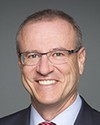Thank you, Mr. Chairman.
I'd like to thank the committee for inviting us to speak.
As Mr. Gilbert has indicated, my name is Burke Thornton, and I'm the immigration program manager in Buffalo. I am joined by Catherine Bailey, who is our deputy program manager.
I'd like to provide a short overview of the program in Buffalo, emphasizing some topics that I believe would be of interest to the committee.
We are an office of 51 people, including Canada-based officers and local staff. Approximately half our staff are Canadian citizens and residents who commute from the nearby communities of Fort Erie, St. Catharines, and the Niagara region, across the bridge daily, to work at our consulate in Buffalo.
I will start the description of the program with the temporary residence program.
Our movement is incredibly varied. We have applicants from more than 160 countries applying at the consulate in Buffalo. Only a very small part of this non-immigrant movement are U.S. citizens, because visitors are visa-exempt, and most U.S. students and workers apply directly at ports of entry into Canada.
Our temporary resident program has been characterized by continuous growth over the past few years. We have set a new record for output every year since 2005. Our intake has increased 64% since 2005, and 25% in the past two years alone.
We have now surpassed New York, our colleagues in New York, as the U.S. mission with the highest non-immigrant application intake, and we have made the top-ten list globally.
Acceptance rates are much higher than global norms, running to about 94% or 95%, as most of our applicants have already been admitted to Canada or the U.S.A. So we have the advantage of having, if you like, a pre-screening done on those applicants.
While we offer walk-in service four mornings a week, approximately 80% of applications are submitted by mail, and we have established a post office box in Fort Erie, Ontario, just across the bridge, so that our Canadian clients can submit applications entirely using the Canadian postal system. Because of the high percentage of mail-in applications, our processing times are lengthier than in most offices where walk-in service is the norm, but still approximately 67% are finalized in 14 days or less.
Here is just a word about students. Our numbers have increased 54% in the last two years. Most of our applicants live in Canada. Korea is the country from which we have the highest intake, with about 18%, and that's followed by the U.S.A., running about 12%.
With regard to temporary foreign workers, again, most of our temporary applicants reside in Canada, having entered as visitors. Buffalo received 2,800 such applications in 2010, which is an 80% increase in the last five years.
With respect to permanent residents, Buffalo is responsible for the intake of all permanent resident applications submitted by persons lawfully admitted to Canada or the United States for at least one year.
We're the regional program centre and the hub of the United States delivery network, and our partner offices are in Detroit, New York, Seattle, Los Angeles, and Washington.
Our office is responsible for the initial review of applications. This includes the creation of the paper and electronic files as well as the initiation of security and criminality checks. Buffalo keeps approximately 50% of the applications and sends the other 50% to the other four U.S. offices for processing.
In 2010, the U.S. delivery network received the highest volume of permanent resident applications, approximately 20,400, and issued the most visas, approximately 38,500, out of all visa offices and regional program centres across the world.
Approximately 15%, or one in six, of all visas issued abroad in 2010 were issued by the U.S. delivery network. We expect similar results for 2011.
A high percentage of applicants are from Canada or residing in Canada, and that is due in part to the growing uptake from the provincial nominee program and Canadian experience class.
I'd like to talk a little bit about provincial nominees and skilled workers. We received the largest volume of nominees, more than 6,000, and issued the most visas in this category, approximately 13,000.
Our application intake has seen a significant shift in recent years. In 2010 the issuance of nominee visas exceeded that of federal skilled workers for the first time in our history. Even so, we delivered a significant proportion of the skilled worker visas in 2010--almost 17,000--and that includes quite a large Quebec skilled worker caseload.
We are responsible for processing all Canadian experience class cases. That movement is going up. We issued 3,900 visas in 2010 and we expect to issue 5,000 in 2011. In the family class priority we issued 3,700 such visas in 2010, again including Quebec cases. That's the second-largest in the world.
Many of these cases are straightforward, but there can be challenges--high incidence of criminal convictions, difficulty in obtaining medical results from non-accompanying dependents, and difficulties in motivating certain applicants to comply with processing requirements. Most of these cases are finalized well within one year. And we are able to finalize 50% of our spousal cases in less than six months, once they're received.
In 2010 we issued almost 450 visas for parents and grandparents. Processing time is currently about 19 months. We expect to issue close to the same number of visas in 2011.
We believe we're in a good position to deliver on our commitments this year and will continue to try to motivate ourselves and our staff to make ourselves the most efficient visa office in the global network.
Thank you.


